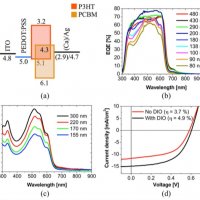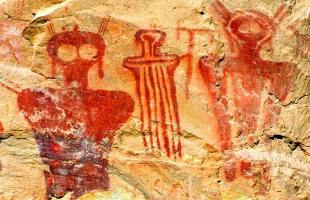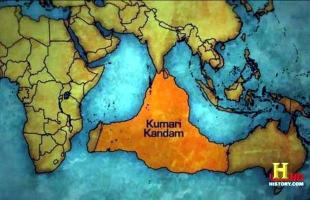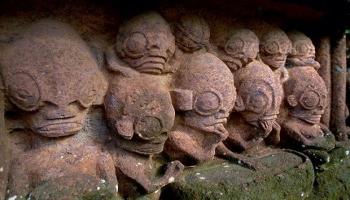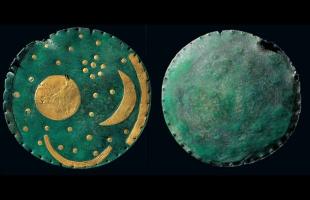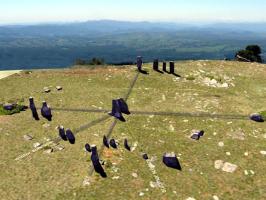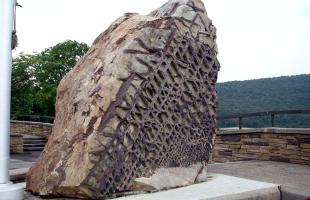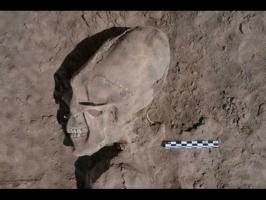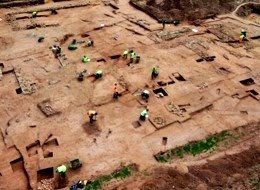The linguistic position of Meroitic
Meroitic was the language of the successive kingdoms of Kush. It was not written before the last stage of the civilization of Kush, the so-called « Kingdom of Meroe ».

However, there is evidence for a much earlier date for the appearance of this language (Rilly, 8th Nilo-Saharan Conference, Hamburg, 2001), although it was not yet written with a script of its own. A list of Proto-Meroitic names of persons, obviously important figures of the first Kushite state, the Kingdom of Kerma, appears in an Egyptian papyrus from the sixteenth century BC.
According to the most recent archaeological work carried out by the University of Geneva, Kerma was founded around 2400 years BC and did not undergo any dramatic ethnic or cultural changes until its final stage. So the origin of Meroitic can now be placed very probably around this date or even a little earlier.
| MEROITIC: CHRONOLOGICAL OUTLINE | ||||||||
| -2400 | -2000 | 1500 | ...........-> | 1000 | 700 | -200 | 0 | +420 |
| Beginning of the Kingdom of Kerma whose language is probably Proto-Meroitic | Princes of Kush and Sai with probable Proto-Meroitic names | 1st traces of Meroitic (names of officers transcribed in Egyptian hieroglyphs). End of Kerma | Egyptian colonisation | End of the Egyptian colonisation | XXVth Dynasty: Egyptian is again the cultural language but the names of the Pharaohs are Meroitic | First trace of the Meroitic script | | Last known Meroitic inscription. Meroitic gives way to Nubian |
MEROITIC: CHRONOLOGICAL OUTLINE
Meroitic is yet for the greatest part untranslatable. Of course, the words can be read since the script was deciphered in 1911 by the British egyptologist F. Ll. Griffith. But the very meaning of these words was nearly unknown. Apart from some names of places, kings and gods, and a few Egyptian loanwords, no more than three dozens of indigenous words could be translated with certainty.
The main problem with unknown ancient languages is to find related languages, ancient or modern, which are known. If an unknown language cannot be linked with any known language, and if there are no extensive bilingual texts, translation is probably impossible. A sad example is Etruscan, which still resists translation in spite of three centuries of hard work with various methods.
It is impossible to prove a genetic relation between given languages if only a few basic words are available, as was the case until recently. Moreover, in the list of the allegedly translated Meroitic words, some were actually wrong. In 1964, Bruce Trigger tried to prove that Meroitic was a Nilo-Saharan - and more specifically an Eastern Sudanic - language. He used a list of Meroitic words compared with Nubian and Nara, a language from Eritrea. But the list was still very scanty, and half the words he used, taken from Zyhlarz's articles, were erroneously translated - or simply did not exist at all. Although he was right in his conclusion, he was wrong in the way he reached them. So the question of the linguistic position of Meroitic remained open after his paper.
The only basic Meroitic words for which a solid translation had been given by Griffith and his successors are the following:
man / woman / meat / bread / water / give / big / abundant / good / sister / brother / wife / mother / child / begotten / born / feet.
The methods to increase the number of translated words cannot be fully explained in details here. To make a long story short, I would say that it is a « multicontextual approach ». The archaeological and the iconographical context can be very helpful, since very often, the short texts are the description with words of a painted or engraved image.

Typological similarity between Egyptian texts and their Meroitic counterparts can also be useful. Of course, the elements of the texts that are known, for example names of persons and gods, can help towards clarifying the grammatical nature and the semantic field of the unknown words. Most of the time, all these elements are insufficient. But in a few cases, a meaning can be suggested for new words and be confirmed in various inscriptions. Although very slow, this approach recently provided new translations. A set of thirtynine purely Meroitic basic words was finally produced, not including of course too specific words such as « prince » or « great priest », which are useless for comparative purpose.
SOME RECENTLY TRANSLATED MEROITIC WORDSarohe - « protect » hr- «eat », pwrite « life », yer « milk» ar «boy », are- or dm- «take, receive», dime «cow», hlbi «bull », ns(e) « sacrifice>>, sdk «journey », tke- « love, revere », We «dog»
The second stage of the work was to reconsider the relation of Meroitic with Nilo Saharan and possibly to spot inside this phylum a specific family where Meroitic could belong. Previous works, including mine, had shown that a link with other phylums like Niger-Congo or Afro-Asiatic was unlikely. For this purpose, lexico statistical methods were used (see below). The most convincing similarities are with Eastern Sudanic, and more specifically with the northern branch including Nubian, Nara, Taman and Nyima. The best result is obtained with Midob (a member of the Nubian group), thanks to Roland Werner's excellent description of this language. The scores of Taman, Nara and Nyima could be higher if there were extensive lexical data available, but unfortunately, only short wordlists have so far been published.
But at this stage of the work, two main obstacles were encountered. First, the distinction between the Northern and the Southern branches of Eastern Sudanic had to be firmly established. Obviously, the scores of some Southern languages like Surmic or Nilotic in the lexico statistical comparison with Meroitic are high. This distinction between both branches was first suggested by Bender in 1991, but on morphological, not lexical, bases. This obstacle is rather easy to overcome: a series of basic words such as « drink », « mouth », « burn », « tooth », « hand », « louse » etc., shows close connections inside the northern branch, but nothing else than scattered similarities with the Southern one. One can even wonder if it would not be relevant to consider North Eastern Sudanic as a single family within Eastern Sudanic, at the same level as Surmic, Nilotic, Daju or Temein.
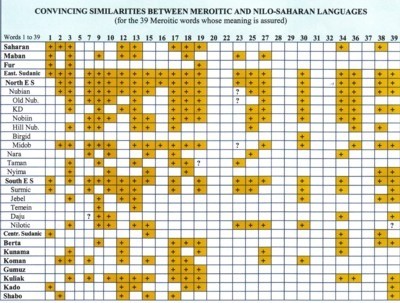
The second problem was more difficult to solve. Lexico statistics are a good method to identify a linguistic family for a language whose genetic nature is unknown. But this approach does not provide definite evidence. The one and only way to get it for sure is the classical comparative method as illustrated by Meillet for the Indo-European family, by Guthrie for Proto-Bantu, etc. So it was necessary, first to find regular phonetic correspondences between North Eastern Sudanic languages, second to reconstruct the original phonology of Proto-North Eastern Sudanic, third to reconstruct, as much as possible, some Proto-North Eastern Sudanic words, and finally to compare these proto-forms with Meroitic words. The task is not easy because extensive data are missing for a majority of the dialects and even for some languages like Afitti or Tama.
Finally, close connections were found between some Meroitic words and their Proto North Eastern Sudanic counterparts (see table below). Some regular phonetic correspondences are obvious. For instance, where Proto-North Eastern Sudanic had /g/ in initial position, it became in Meroitic the velar fricative /h/ or /h/: the example displayed in the table below is « meal » or « food », but there are other instances. Most of the time, the correspondences are simple: initial /k/ in Proto-North Eastern Sudanic is preserved everywhere except in Nyima, where it often turns into dental /t /. There are sometimes very impressive sets like the words for « take, receive », « woman », « slaughter » and particularly the name of the supreme god (Meroitic Apede-mk:« the God Apede »),a detail which indicates that the speakers of Proto-North Eastern Sudanic formed not only a linguistic, but also a cultural community.
Some Examples of Lexical Correspondences between Meroitic and North Eastern Sudanic
| Meroitic | Proto-nes | Nara | Proto-Nubian | Proto-Taman | Nyima |
| are [e r] | *ar "take" | (hind) "take" | *aar- "take" | ε r- "buy" | - |
| dm-[d,am] "take, receive" | *dom- "pick up, take" | mem-"pick up, take" | *dumm- "pick up, take" | - | dumud-"pick up" |
| hre [xar] "meal" | *go(o)r "eat (tough food) | - | goor"gnaw" | - | t orom / kworom"gnaw" |
| kdi [kadi]or[Kandi] "woman" | *kari or * kandi "woman" | kede"sister" | *kari "female" | - | ke r"woman" |
| ked-[ked,]or[ke d,] "slaughter" | *kod- "slaughter" | kad-"slaughter" | *n od- "slaughter" | - | t ai- / kai-"slaughter" |
| wle [wal] "dog" | *wel "dog" | (wos) "dog" | *wel "dog" | (*wiis) "dog" | wtl (A) "dog" |
| yer[era]or[ira] "milk" | *er- "milk","breast" | (sa) "milk" | er-ti"breasts" | (*sun) "milk" | élo"milk" |
| Apede-[e bed, e] in Apede-mak (mk "god") | *Ebede "Creator God" | Ebbere"God" | *Ebed- "God" | - | Abidi"Creator God" |
(*) Little data for Taman is available for those items. But the Taman group is clearly a member of the NES-family because of its obvious relation with Nubian.
Other correspondences are less obvious. For example, original /g/ in internal position, if in contact with a labiovelar vowel [o] or [u], becomes /b/ in Meroitic. This phenomenon is known in other linguistic families, for instance Celtic among the Indo-European phylum (cf. Greek gune «woman ) ) vs Gaulish bena ).Moreover, initial dental consonant /d/ becomes often the liquid /V in Meroitic. This change is also common in other languages, opposing for example the English word tongue (where /t / < /d n and its Latin counterpart lingua. According to both these phonetic rules, the Meroitic article -l pronounced /la/, plural -leb,pronounced /laba/, and Nara demonstrative te,plural tegu, are related, both issuing from Proto-North Eastern Sudanic *de, plural *degu. So the correspondences between Meroitic and living North Eastern Sudanic languages can be found not only in lexical items, but also in morphological elements.
In spite of the scanty available data, the result is obvious: Meroitic is more than probably a member of the North Eastern Sudanic family.
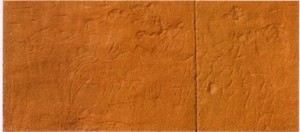
Moreover, the map of these languages [see above] shows an interesting feature. Nowadays, these languages are scattered from Chad to Eritrea, but in the past, there was a link between their present situations: the WadiHowar, an ancient river, now dried up, once an important tributary of the Nile. In the fourth millenary BC, all the region around this river was still a green country convenient for cattle-breeding. But around this time, this part of the Sahara became arid. Very probably, the pastoral populations living in the region were progressively obliged to gather together along the banks of the WadiHowar. There they lived together for centuries and acquired a common language: Proto-North Eastern Sudanic. But in the beginning of third millenary BC, the river itself progressively dried up. So a first population migrated to the Nile, where they founded the Kingdom of Kerma, not far from the confluence of the WadiHowar and the Nile. The geographical, historical and climatic data offer a common support to this theory.
The Taman group went East, towards the springs of the river, to the place where they still live today. Another refugee group, the ancestors of Nubian and Nyima speakers, went South to Kordofan, where they still live today. Later on, in the first centuries AD, Nubian groups invaded the dying Kingdom of Meroe and founded their own kingdoms along the Nile. As for Nara people, I think they first went to the Nile, like the future Meroites, and later went up the Nile and the Atbara toward Eritrea, where they live nowadays.












